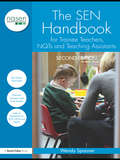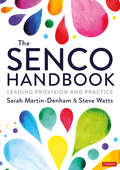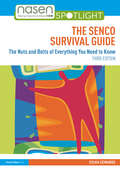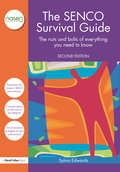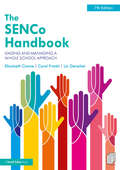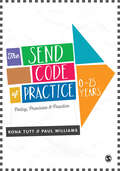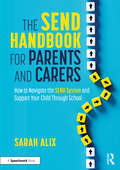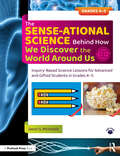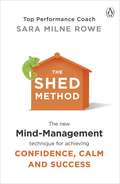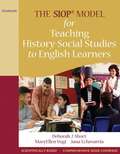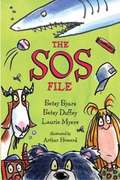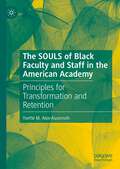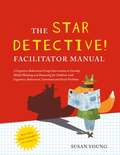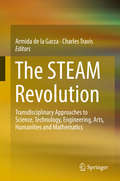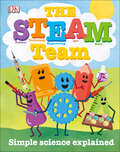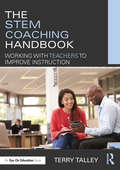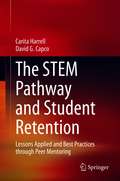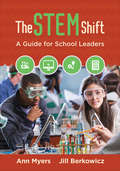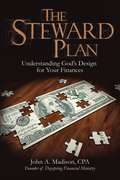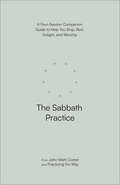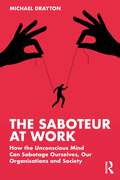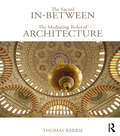- Table View
- List View
The SEN Handbook for Trainee Teachers, NQTs and Teaching Assistants (nasen spotlight)
by Wendy SpoonerAccessibly written with the needs of trainee teachers and Higher Level Teaching Assistants in mind, this new edition of Wendy Spooner’s popular SEN Handbook provides an up-to-the-minute introduction to key issues. Student teachers and teaching assistants will find the case studies and vignettes invaluable as they bring these issues to life, and present important opportunities for reflection on how these issues relate to practice. Core standards for teachers, QTS and HLTA qualifications are highlighted enabling the reader to understand exactly what is expected of them – and how to achieve it. Coverage includes: self-assessment of your own attitudes towards SEN issues legal definitions and current legislation and guidance identification, assessment and support for children with SENs across the Key Stages issues of inclusion and exclusion a range of teaching approaches and strategies school-based training and SEN issues that may arise further reading, websites and resources lists. Practical and comprehensive, this is an invaluable resource for all teaching professionals working towards providing inclusive learning environments.
The SENCO Handbook: Leading Provision and Practice (Corwin Ltd)
by Ms. Sarah Martin-Denham Steve WattsThis Handbook will give aspiring and practising SENCOs, teachers, Headteachers and Governors an in-depth knowledge and understanding of effective policy, provision and practice to meet the diverse needs of children with special educational needs and disabilities. Each chapter will provide: A theoretical underpinning Evidence-based information and examples Activities for professional learning and whole school development Easy to use and adaptable templates and checklists for use in settings Case studies to strengthen connections between theory and practice Providing comprehensive coverage of current issues, the understanding of how to improve provision and practice in their settings and written with consultation from practising SENCOs, this is essential reading for those studying towards their National Award for Special Educational Needs Co-ordination.
The SENCO Handbook: Leading Provision and Practice (Corwin Ltd)
by Ms. Sarah Martin-Denham Steve WattsThis Handbook will give aspiring and practising SENCOs, teachers, Headteachers and Governors an in-depth knowledge and understanding of effective policy, provision and practice to meet the diverse needs of children with special educational needs and disabilities. Each chapter will provide: A theoretical underpinning Evidence-based information and examples Activities for professional learning and whole school development Easy to use and adaptable templates and checklists for use in settings Case studies to strengthen connections between theory and practice Providing comprehensive coverage of current issues, the understanding of how to improve provision and practice in their settings and written with consultation from practising SENCOs, this is essential reading for those studying towards their National Award for Special Educational Needs Co-ordination.
The SENCO Survival Guide: The Nuts and Bolts of Everything You Need to Know (nasen spotlight)
by Sylvia EdwardsThe SENCO Survival Guide, Third Edition is an informative, accessible resource containing practical advice to help SENCOs manage their responsibilities and lead their school effectively towards a common goal. The book sets out a whole school approach to inclusion and supports SENCOs in mainstream or special schools at every key stage. This fully revised new edition features: a focus on high quality teaching, with ideas for classroom practice to include and engage all children and young people an introduction to SEN support and education, health and care plans, based on the Code of Practice graduated response strategies to break the cycle of SEND low achievement and guidance on how to create a SEND-friendly environment advice on the role of the modern SENCO, including assessment, provision mapping, preparing for OFSTED, disability discrimination and equality advice on training, managing and deploying teaching assistants effectively strategies to improve ‘pupil voice’ and independence ways in which the enhanced role of parents can be harnessed in order to achieve maximum success for learners with SEND conclusions from the author’s new ‘field research’ in mainstream, special and Post-16 settings. This resource gives SENCOs the confidence, skills and knowledge to promote maximum achievement for learners with SEND and will help them develop and shape their schools’ policies and practices. It will also be of use to other members of staff looking for practical strategies to raise the attainment of pupils with SEN and disabilities.
The SENCO Survival Guide: The nuts and bolts of everything you need to know (nasen spotlight)
by Sylvia EdwardsStill the best ‘all round’ guide for SENCOs on the market’ Pippa Whittaker, Curriculum Leader for Inclusion, City Academy, Bristol The SENCO Survival Guide is an informative resource, fully updated with the new 2014 SEND Code of Practice and containing practical advice to help SENCOs manage their responsibilities and lead their school effectively towards a common goal. In light of current developments, this resource sets out the government's fresh agenda for whole school discussion and helps SENCOs in mainstream or special schools at every stage to manage changes in SEND policy and practice. With up to date information on the changes taking place to support learners with SEN and disabilities, this fully revised new edition also includes: strategies to break the cycle of SEND low achievement advice on crucial aspects of the SENCO role, including assessment, provision mapping, preparing for OFSTED, disability discrimination and equality advice on training, managing and deploying teaching assistants effectively ways in which the enhanced role of parents can be harnessed in order to achieve maximum success for learners with SEND. This book will give SENCOs the confidence, skills and knowledge to promote maximum achievement for learners with SEND in all schools, across all key stages and will support them in their role to develop and shape their schools’ policies and practices on SEND. This book will also be of use to other members of staff looking for practical strategies to raise the attainment of all pupils with SEN and disabilities.
The SENCo Handbook: Leading and Managing a Whole School Approach
by Elizabeth Cowne Carol Frankl Liz GerschelThis seventh edition of the best-selling The SENCo Handbook has been updated to reflect the impact that the implementation of the SEND Code of Practice (DfE/DoH 2015) has had on policy and practice in schools and for SENCos. It provides vital information on statutory requirements, practical approaches to the SENCo role and responsibilities and perceptive analysis of issues relevant to all schools, Early Years settings and colleges. Debate and discussion of the different aspects of the SENCo role reveals how it has changed and will change. Written in an accessible and informative format, with numerous examples of good practice, this book will help all SENCos, headteachers and school leaders to create and implement effective whole school policies for special educational needs. Key topics include: leading and managing change in SEND policy and practice developing whole school approaches to policy and practice for SEND building capacity of class and subject teachers to meet the needs of all pupils managing and leading the assess, plan, do, review response to those identified with additional needs leading on the deployment and management of support staff working with children, young people and their parents, especially in relation to those requiring EHC Plans working in partnership with range of outside agencies and services the historical context and management of current SEND law and administration Photocopiable training materials are included as are new resources in appendices and source lists. The SENCo Handbook remains essential reading for those studying for the National Award for SEN Co-ordination, whilst more experienced SENCos will value its academic underpinning and practical advice on issues that matter.
The SEND Code of Practice 0-25 Years: Policy, Provision and Practice
by Paul Williams Rona TuttConsidering it for your course reading list? Lecturers can order their e-inspection copy here today! How have you found the changes brought about by the new SEND Code of Practice: 0-25 years (2014)? This book is the ultimate guide to making sure that you are not only meeting the requirements, but are improving outcomes for children and young people as well. Written for all professionals working in the field, it covers: · The broader Children and Families Act (2014) · The role of the local authority · Guidance on all the key changes that school leaders, SENCO's, and staff are concerned about · Case studies of settings across the 0-25 age range, including maintained schools, academies, free schools, and specialist and alternative provision. Whether you work in education, health, or social care, or are training to do so, this book will genuinely improve your provision and practice for children and young people with SEND.
The SEND Code of Practice 0-25 Years: Policy, Provision and Practice
by Paul Williams Rona TuttHow have you found the changes brought about by the new SEND Code of Practice: 0-25 years (2014)? This book is the ultimate guide to making sure that you are not only meeting the requirements, but are improving outcomes for children and young people as well. Written for all professionals working in the field, it covers: · The broader Children and Families Act (2014) · The role of the local authority · Guidance on all the key changes that school leaders, SENCO′s, and staff are concerned about · Case studies of settings across the 0-25 age range, including maintained schools, academies, free schools, and specialist and alternative provision. Whether you work in education, health, or social care, or are training to do so, this book will genuinely improve your provision and practice for children and young people with SEND.
The SEND Handbook for Parents and Carers: How to Navigate the SEND System and Support Your Child Through School
by Sarah AlixBeing a parent of a neurodivergent child can be challenging and exhausting. It can feel like a constant battle to be heard and to gain the support that you and your child need. This book provides an accessible overview of the SEND system and how it works, so that you can successfully untangle and navigate the system and draw upon the best resources offered.The handbook is divided into three main parts: SEND systems, policy and legislation; support for your child in school; and looking forward. Chapters: Introduce the world of SEND systems and break down key documentation and the roles and responsibilities of school staff Take you on your child’s journey through school and explore key aspects from assessment and EHCPs, to funding and gaining further support for your child Look ahead and consider important transitions through each of the school phases in your child’s journey and allows you to acknowledge some of your own fears and challenges as a parent Include a range of both practical and reflective activities to bring each area to life The voices of parents and carers are woven in throughout the book, as well as key staff who you might encounter, from occupational therapists to speech and language therapists. This comprehensive guide will be an essential tool to support your journey to get the best from your child’s school experience.
The SENSE-ational Science Behind How We Discover the World Around Us: Inquiry-Based Science Lessons for Advanced and Gifted Students in Grades 4-5
by Jason S. McIntoshEmbark on a journey of discovery by connecting with the five senses in this 30-lesson interdisciplinary science unit geared toward the fourth and fifth grade. Students will use their senses as a springboard to explore advanced concepts such as the science behind cooking, optical illusions, musical instruments, and more. They will learn to distinguish between physical and chemical changes, describe the movement of sound waves, classify optical illusions, and evaluate the validity of their discoveries through unique problem-based learning tasks. Featuring detailed teacher instructions, daily reflection activities, and reproducible handouts, this unit makes it easy for teachers to adjust the rigor of learning tasks based on students’ interests and needs. Aligned with Common Core State Standards for English Language Arts and Mathematics and Next Generation Science Standards, both gifted and non-gifted teachers alike will find this unit engaging, effective, and highly adaptable.
The SHED Method: The new mind management technique for achieving confidence, calm and success
by Sara Milne RoweMake 2020 your best year yet with the help of the The Shed Method - step-by-step advice to give you the drive to go after what you want and achieve real success.'A new way to tackle life's challenges. Teaches you to get the best out of yourself' RedUse your SHED - Sleep, Hydration, Exercise, Diet - to lock up negative thoughts and find the success you deserve.Do you make poor choices when tired or stressed?Is happiness perpetually out of reach?Have you lost direction?The SHED Method is a means of taking control of the reptile (fight or flight) and dog (bark or cower) parts of your brain to ensure you are always in control of your life and decisions. By managing your SHED you will:· Stop being your own worst enemy · Recognise internal warning signs· Turn negative emotions and thoughts into positive ones· Make better decisions when it matters Based on over ten years of coaching high performers, Sara Milne Rowe's The SHED Method is full of easy-to-follow advice, practices and routines to help you become a happier, healthier and more confident you.
The SIOP Model Teaching History-Social Studies to English Learners
by Jana Echevarria Mary Ellen Vogt Deborah J. ShortThis highly anticipated book addresses the issues faced in teaching history-social studies to English learners (ELs) at each grade-level. SIOP techniques and activities organized around the eight SIOP components guide educators in promoting academic language development along with comprehensible content. <p><p> Written for SIOP teachers and those who have learned the SIOP Model, this book includes proven, effective lessons and comprehensive units. In addition, this book provides ideas to adapt the techniques for students at different levels of English proficiency. This book is sure to become an indispensable resource for history-social studies educators of English learners. <p><p> Presents a systematic process for teaching both the academic content of history-social studies and its associated academic language to English learners. Offers ideas and activities about teaching history-social studies and organizes activities by grade-bands–K-2, 3-5 (or 6), 6-8, and 9-12 and SIOP components. Provides use-tomorrow ideas and activities for implementing the eight components of the SIOP Model in a history-social studies classroom. Includes lesson plans and comprehensive units that illustrate how a particular activity can be effective for ALL students, not just English learners.
The SOS File
by Betsy Byars Betsy Duffey Laurie MyersThe students in Mr. Magro's class submit stories for the SOS File about their biggest emergencies, and then they read them aloud for extra credit.
The SOULS of Black Faculty and Staff in the American Academy: Principles for Transformation and Retention
by Yvette M. Alex-AssensohThis book employs a fiction-based approach to address the revolving door of Black faculty and staff in American colleges and universities as a national crisis that needs to be resolved systematically. Alex-Assensoh coins the acronym SOULS to promote the importance of safety, organizational accountability, unvarnished truth telling, love, and spirituality as the foundational ingredients for reimagining and rebuilding an Academy that harnesses the talents of Black faculty and staff. Chapters feature storytelling to illustrate common cracks in academic structures while interweaving interdisciplinary research to contextualize themes that the fiction-based method reveals. To conclude, the author provides a research-informed call to action within the context of institutional transformation, as well as reflective questions and recommendations for further reading.
The STAR Detective Facilitator Manual: A Cognitive Behavioral Group Intervention to Develop Skilled Thinking and Reasoning for Children with Cognitive, Behavioral, Emotional and Social Problems
by Professor Susan YoungThe STAR Program is designed to teach children and those involved in their care psychological techniques to improve self-control and prosocial competence. The program employs cognitive-behavioral therapy (CBT) principles and uses a child-centered approach to teach attention skills, emotional control, problem-solving, and interpersonal skills to children aged 8-12 who have cognitive, behavioral, social or emotional difficulties. This manual includes designated group sessions to be delivered by healthcare practitioners alongside individual coaching sessions to be provided by a family member or individual carer between each group meeting. Extra materials include PowerPoint presentations, and a Thinking Tools resource, which are available to download from the JKP website.
The STEAM Revolution: Transdisciplinary Approaches to Science, Technology, Engineering, Arts, Humanities and Mathematics
by Charles Travis Armida de la GarzaThis volume is dedicated to collaborative research across STEM disciplines, the arts and humanities. It includes six sections, framed from a global perspective and exhibits contributions from key experts in the field, emerging scholarly voices, and STEAM practitioners. The added value of STEAM projects in research is highlighted in the first section of this book. Ranging from the spatial, medical and environmental humanities to heritage science, this section discusses the course and paths STEAM projects may evolve to in the near future. The second section features reflective essays by scientists and artists on the development of their research, their professional growth and personal learning experiences that the art/science collaborations have afforded their work and careers. Sections III and IV provides practical guidance and advice on facilitating STEAM teams and describe successful collaborative projects. By presenting the objectives and outcomes of relevant research, the chapters in these sections discuss the various steps taken by different teams to achieve project fruition. Paying particular attention to barriers inhibiting STEAM collaboration, these sections also explore the ways in which research teams were able to work effectively. The fifth section presents a review of policy issues and the potential impacts of STEAM research for administrators, funders and policy makers. In its pursuit for balance and inclusion, the volume concludes with a critical reflection on STEAM that argues a different perspective and will prove food for thought to readers.
The STEAM Team: Simple Science Explained
by Lisa BurkeThe zany characters of The STEAM Team will guide kids through this engaging, fact packed kid's book all about the key subjects - science, technology, engineering, art, and math.An excellent introduction for children ages 5-7 to understanding these concepts, The STEAM Team is a colorful, well-presented education book for children that will get your little ones crazy for STEAM subjects!This brightly illustrated science book for kids breaks down STEAM subjects and complicated ideas into fun and easily understandable pieces. Join The STEAM Team to unravel the mysteries of science for kids - find out how robots work, what a food chain is, where lightning comes from, and much more!The STEAM Team characters (Science, Technology, Engineering, Art, and Math) guide the reader through the book and are always on hand with tips, fun facts, and simple explanations. The ingeniousness of The STEAM Team is the characters - keeping little ones engaged and engrossed throughout. In these pages the Team cover living things, the human body, space, physics, geography, math, engineering, and chemistry. This book is a fantastic first children's book for kids starting to learn STEAM subjects in school, or who are developing an insatiable interest in the world around them.Meet The Steam Team!The STEAM Team is made up of five cool characters (subjects) that work together to show you how the world works. Science is all about asking questions and discovering the answers to explain how things work. Technology uses science to create new machines and effective ways of doing things. Engineering is all about finding and designing solutions to problems - using science, technology, and math. Art is all about using your imagination and style to create brilliant new things. Math is about numbers, patterns, and problem solving. They are the perfect team to teach you all about STEAM - Science, Technology, Engineering, Art, and Math!Find out what science is, why it is so important, and how it relates to the world around you. Discover how machines work, what a food web is, why boats float, where lightning comes from, and much much more!From Amphibians to Darwin to the Internet, this book is full of interesting STEAM facts covering: - The Universe- Plants- Robots- The human body- Measuring- Climate Change- And so much more!If you are looking to add more books to your collection that answer the questions about the world, give Ask A Scientist a try for the little "why?" askers in your life.
The STEM Coaching Handbook: Working with Teachers to Improve Instruction
by Terry TalleyLearn how to promote STEM integration in your school district and increase student achievement. In this helpful, easy-to-read book, author Terry Talley sheds light on the key responsibilities and accountabilities of a successful STEM coach and offers a wealth of practical advice for those new to the position and for those who want to refine their skills. You’ll discover how to… Build positive working relationships with teachers and faculty Organize professional development opportunities such as PLCs and book study groups Develop hands-on instructional strategies based off the needs of your students and the strengths of your staff Promote technological and scientific literacy to prepare students for success in the 21st Century Enhance student engagement using project-based learning and growth-based assessment models Designed to be read either as a step-by-step guide or as a reference, The STEM Coaching Handbook is loaded with insights and accounts from experienced STEM educators across the country. No matter your level of expertise, these tips will help you make your district’s STEM program more effective for all students.
The STEM Pathway and Student Retention: Lessons Applied and Best Practices through Peer Mentoring
by David G. Capco Carita HarrellThis work introduces methods that aid in freshman retention (in the transition from high school and to remain in the university of origin) and orient them towards a successful career in science. Specific examples of successful approaches are given as well as detailed plans for how to engage these students. Pitfalls as well as success are described. In addition this work provides a detailed description of how to develop the students into a cohort that exhibits comradery. Three types of cohort form, those within the freshman class, those among the upperclassmen and those between the freshmen and upperclassmen. The program works because the social reality is that the peer mentor has a better repertoire with the first semester freshmen than the faculty or staff and assists with student success. Factors such as financial aid, policy, and support systems influence student success. In the sciences, students often struggle with the content and adjusting to the college experience. Research states that a mentorship program supports retention as well as enhances the student experience during college. This program creates a cohort group among the upperclassmen mentors and freshmen and provides leadership development for all involved.
The STEM Shift: A Guide for School Leaders
by Ann P. Myers Jill BerkowiczAll you need to make the shift to STEM a reality! Now more than ever, educational leaders are encouraged to implement STEM as the foundation for preparing students with the 21st century skills required for college and career readiness. This resource makes the process of shifting to a comprehensive, integrated STEM school or district within reach! Invaluable case studies featuring current STEM pioneers from across the country model how successful, STEM-centered learning takes place. You’ll find process-specific best practices and strategies to help you: Understand, create, and lead the STEM change process Transform existing school programs Prepare the school community for STEM and plan for STEM integration Integrate 21st Century Skills, the arts, and humanities Create essential partnerships with business and higher education Includes step-by-step checklists and visual mapping guides for successfully navigating the STEM change process. Use this groundbreaking resource to systematically implement coherent and integrated STEM instruction that transforms learning and prepares students for the global economy! Video and web content also available at http://bit.ly/TheSTEMShift. "Finally! A great book that clearly explains what STEM education is, why we need it, and how to do it well. A must-read for all educators, parents, and policymakers." Tony Wagner, author of The Global Achievement Gap and Creating Innovators "Reading Jill and Ann′s column in Education Week has been a critical part of my weekly reading since they′ve begun writing it. I′ve learned a lot from those short snippets, and now it′s exciting to see their expanded thoughts in The Stem Shift. You can′t go wrong by reading anything they write!" Larry Ferlazzo, High school teacher and Ed Week columnist
The STEM Shift: A Guide for School Leaders
by Ann P. Myers Jill BerkowiczAll you need to make the shift to STEM a reality! Now more than ever, educational leaders are encouraged to implement STEM as the foundation for preparing students with the 21st century skills required for college and career readiness. This resource makes the process of shifting to a comprehensive, integrated STEM school or district within reach! Invaluable case studies featuring current STEM pioneers from across the country model how successful, STEM-centered learning takes place. You’ll find process-specific best practices and strategies to help you: Understand, create, and lead the STEM change process Transform existing school programs Prepare the school community for STEM and plan for STEM integration Integrate 21st Century Skills, the arts, and humanities Create essential partnerships with business and higher education Includes step-by-step checklists and visual mapping guides for successfully navigating the STEM change process. Use this groundbreaking resource to systematically implement coherent and integrated STEM instruction that transforms learning and prepares students for the global economy! Video and web content also available at http://bit.ly/TheSTEMShift. "Finally! A great book that clearly explains what STEM education is, why we need it, and how to do it well. A must-read for all educators, parents, and policymakers." Tony Wagner, author of The Global Achievement Gap and Creating Innovators "Reading Jill and Ann′s column in Education Week has been a critical part of my weekly reading since they′ve begun writing it. I′ve learned a lot from those short snippets, and now it′s exciting to see their expanded thoughts in The Stem Shift. You can′t go wrong by reading anything they write!" Larry Ferlazzo, High school teacher and Ed Week columnist
The STEWARD Plan: Understanding God's Design for Your Finances
by John A. Madison, CPA.Does the Bible really offer guidance for the complicated financial system in our world today? CPA, author and personal financial counselor John Madison offers a resounding yes! Since retiring from full-time work as a CPA at the age of 49, he has written his new book, The Steward Plan, which explores how following Biblical guidelines can lead people at any stage of life to financial success God&’s way.The Steward Plan covers many aspects of becoming the financial steward God desires, including how to set financial goals, tithing guidance and strategies, creating a blueprint for spending, eliminating debt from your life, growing your wealth wisely over time, removing unnecessary risk from your financial life, and developing a plan to bless future generations. Combining Scripture with practical and easy-to-understand financial terms, The Steward Plan will help you gain control over your money and live the life God designed for you.The Steward Plan is an outgrowth of Dayspring Financial Ministry, whose mission is to teach Biblical financial stewardship. Like all of Dayspring&’s programs, The Steward Plan does not promote or attempt to sell any specific insurance or investing products. It is an independent source of financial information and education, free of any bias, other than conformity with Scripture.
The Sabbath Practice: A Four-Session Companion Guide to Help You Stop, Rest, Delight, and Worship
by Practicing the Way John Mark ComerIn our era of chronic exhaustion, learn how setting aside 24 hours to stop, rest, delight, and worship restores joy and spiritual vitality in this guide from New York Times bestselling author John Mark Comer and the team at Practicing the Way.This Companion Guide to the Sabbath Practice from Practicing the Way provides a practical, accessible approach to incorporating this life-giving rhythm into your weekly routine. Designed to be used with four engaging video sessions freely available online, this guide offers spiritual exercises, reflection questions, and additional resources to help you and your community experience Sabbath as the best part of your week.This guide will help you:• Understand the biblical foundations of Sabbath• Learn to &“stop&” and align with a rhythm God built into the fabric of creation• Develop personal practices for meaningful rest, play, and communal celebration• Resist internal and external forces that war against Sabbath• Cultivate a spirit of worship that extends throughout your weekDiscover how setting aside 24 hours can transform every day of your week, leading to a deeper connection with God, others, and your own soul.
The Saboteur at Work: How the Unconscious Mind Can Sabotage Ourselves, Our Organisations and Society
by Michael DraytonThe Saboteur at Work describes how unconscious psychological processes can sabotage individual lives, the functioning of groups, teams and organisations, and even global politics. Drawing on research in the fields of psychology and organisations, this comprehensive yet straightforward and accessible book enables you to understand how the unconscious can impact progress and performance and describes practical techniques you can use to overcome the saboteur, individually and at work. The book discusses the modern understanding of our adaptive unconscious, and you will learn about repression, imposter syndrome and other defence mechanisms. Ideas are brought to life using real-world examples and personal, organisational and national stories. The book explores the mind’s capacity for self-deception by telling the story of Tony Blair and the invasion of Iraq and looks at unconscious processes in organisations, asking what role the saboteur played in huge corporate failures such as the collapse of Barings Bank and the Boeing 737 Max scandal. The saboteur also operates on a larger scale – governments and societies can be sabotaged by this unconscious force. In Nazi Germany, how did normal, decent people behave like monsters, colluding with or actively participating in the murder of innocent people? Why did big US corporates like IBM, Ford and Chrysler work with the Nazis to make the Holocaust possible? If you manage a team or lead an organisation, you need to understand the role played by the saboteur in your workplace and in your own career and life. This book enables leaders and managers to develop their leadership skills by understanding how the unconscious impacts individual, group and social processes. It will also be of use to coaches and organisational consultants working in the areas of teams and performance.
The Sacred In-Between: The Mediating Roles of Architecture
by Thomas BarrieThe sacred place was, and still is, an intermediate zone created in the belief that it has the ability to co-join the religious aspirants to their gods. An essential means of understanding this sacred architecture is through the recognition of its role as an ‘in-between’ place. Establishing the contexts, approaches and understandings of architecture through the lens of the mediating roles often performed by sacred architecture, this book offers the reader an extraordinary insight into the forces behind these extraordinary buildings. Written by a well-known expert in the field, the book draws on a unique range of cases, reflecting on these inspiring places, their continuing ontological significance and the lessons they can offer today. Fascinating reading for anyone interested in sacred architecture.
